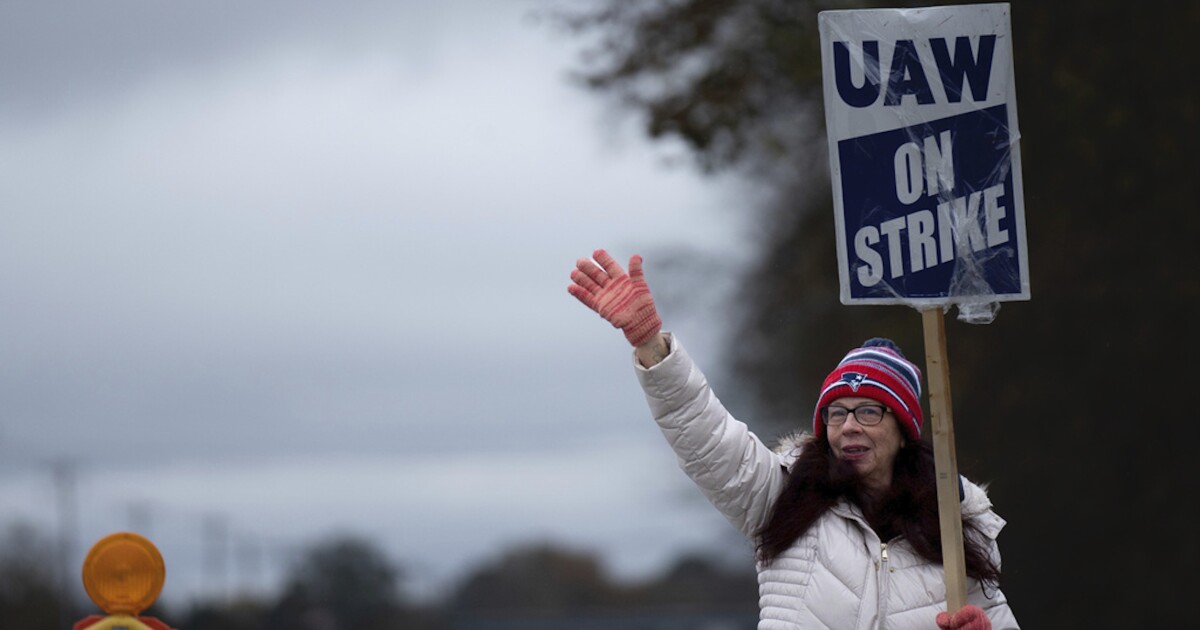

The six-month United Auto Workers strike was historic in its scope and the demands involved, but the work stoppages also have made their mark on the broader economy.
The UAW strike began on Sept. 15, and it eventually involved more than 45,000 workers from the “Big Three” automakers at eight assembly plant locations and 38 parts distribution facilities across nearly two dozen states. After frenzied negotiations, tentative agreements have now been reached with Ford, Stellantis, and General Motors.
UAW AND GENERAL MOTORS REACH TENTATIVE AGREEMENT
The agreements came at the right time and will dampen some of the economic repercussions of the strike, although economists will still be able to point to the stoppages as drivers for some economic slowdown, although probably minimal.
Robert Handfield, a professor of operations and supply chain management at North Carolina State University, said that he expects there will be a small negative effect on gross domestic product growth this quarter as a result of the strike activity. He said that in addition to some of the workers who were striking taking home less pay, some of the auto dealerships might have experienced problems because of a lack of availability of service parts.
Still, he said he doesn’t think that the dealers were hurt too badly by the multiweek stoppages because of excess inventory on hand.
“Overall, there might be a slight dip, but I don’t anticipate it’s going to be significant, maybe half a [percentage] point or something like that,” Handfield told the Washington Examiner.
The slight decrease in GDP growth brought on by the strikes will also be mitigated by the fact that GDP growth has already been stronger than expected.
Economic growth accelerated to a 4.9% seasonally adjusted annual rate in the third quarter of this year, up from 2.1% the quarter before, the Bureau of Economic Analysis reported. That was above the expectations of economists for a 4.2% increase.
Piyush Shah, a supply chain management professor at Florida Gulf Coast University, told the Washington Examiner that he thinks the country’s overall GDP will take a hit, albeit a minor one, from the strikes.
He explained that the three companies account for about 1.2% to 1.5% of the country’s annual GDP, or more if suppliers are included. Additionally, at the strike’s peak, just about one-third of the total employees were on strike, further diminishing the economic fallout.
Handfield said that minor changes in GDP isn’t the only thing that has been affected by the work stoppages. Auto prices might trend up because of decreased supply brought on by the strike, which ended up lasting 44 days before all three of the major automakers reached tentative agreements with the union.
“I think we did see a bit of an increase in auto prices — I think dealers stopped offering discounts so their margins were higher and automotive prices were higher,” he said.
It is also important to note that workers at these auto production plants can’t just turn on and off the facilities, operations, and related supply chains, according to Handfield. Now that the strike is over, it might end up taking a week or more to get back into gear and ramp up to full production, adding to the economic impact, he said.
While there might be some fallout on prices, Shah said that because prices were already under so much pressure during the pandemic and the work stoppages only affected some of the supply of new cars (many are imported), the effects may be minimal.
Regions of the U.S. where the shuttered plants are located will also experience more pronounced economic effects from the strikes than other locations. Michigan has the most plants on strike and is expected to have experienced outsize effects.
For example, the last time UAW went on strike — a six-week stoppage against GM in 2019 — it cost the auto giant some $3.6 billion, and Michigan, home of many GM workers, experienced a recession during that quarter.
Patrick Penfield, a professor of supply chain practice at Syracuse University, said that the strike ended at just the right time to avoid much more severe economic effects. The timing teed up the auto manufacturers to go into overdrive in the lead-up to the holiday shopping season, which could have been severely affected if the work stoppages dragged out into November and December.
“You got it right at the end of the third quarter,” he told the Washington Examiner. “You can produce a lot more cars now in time for the holidays and you’ll see, there will probably be a lot of promotions, a lot of commercials trying to sell as many cars as they possibly can in the end of the fourth quarter.”
Penfield said that if the strike overlapped with the holiday season, it could have had “a major impact to GDP.”
Dan Bowling, a distinguished fellow at Duke University School of Law where he teaches labor and employment courses, told the Washington Examiner that while there is no duty for unions to consider the broader economic effects of a strike, it might behoove some of the larger unions to do so, because if a strike becomes too disruptive to the economy and leads to job cuts, it could come back to bite union members.
CLICK HERE TO READ MORE FROM THE WASHINGTON EXAMINER
The economy is so intertwined through supply chains — as the pandemic made abundantly clear — strikes could have the ability to ricochet through the economy and labor market even more today than perhaps several years ago, according to Bowling.
“I don’t think the unions should totally dismiss in any field the impact it has on the huge numbers of jobs of suppliers upstream and downstream, distributors — strikes this large at least should be considered for their overall economic impact on the economy as a whole,” Bowling said. “I think that should be thought about by unions.”







